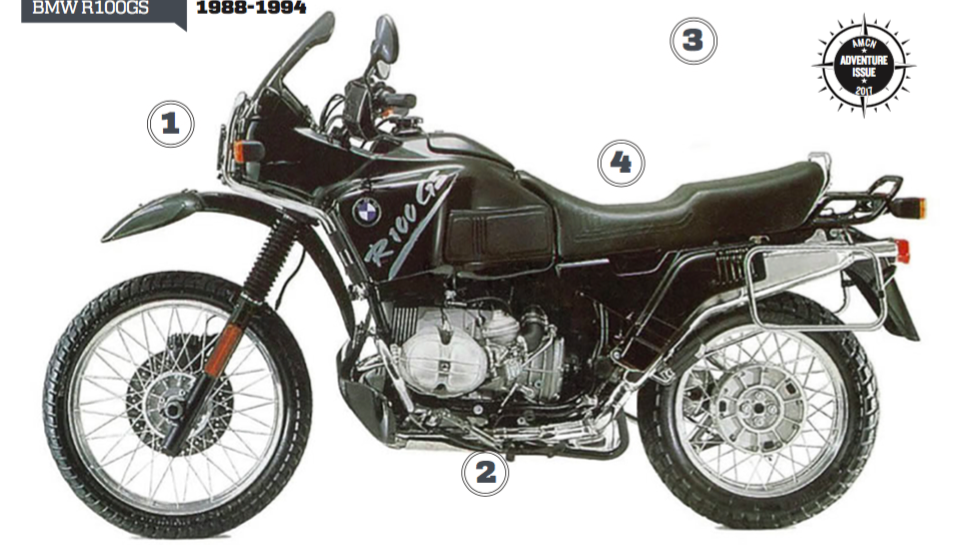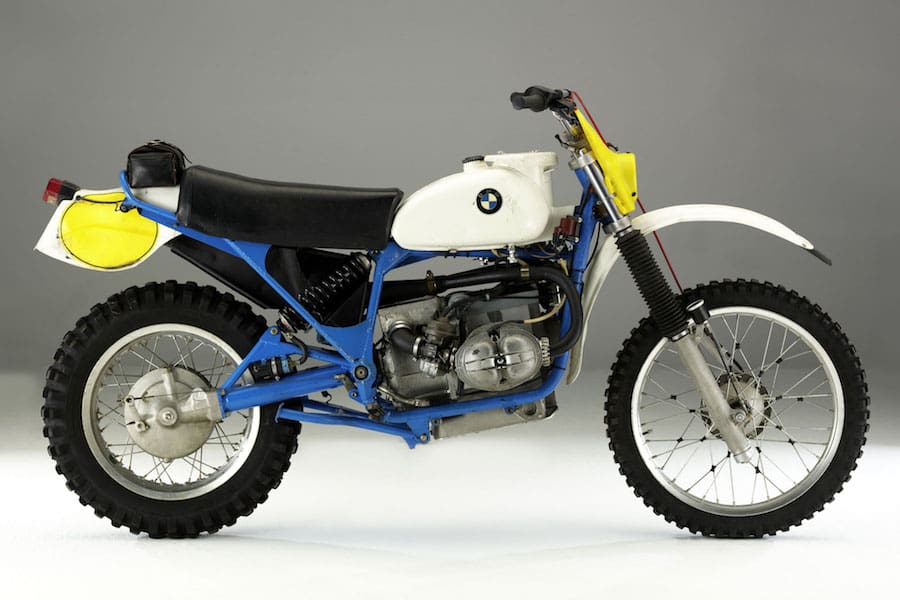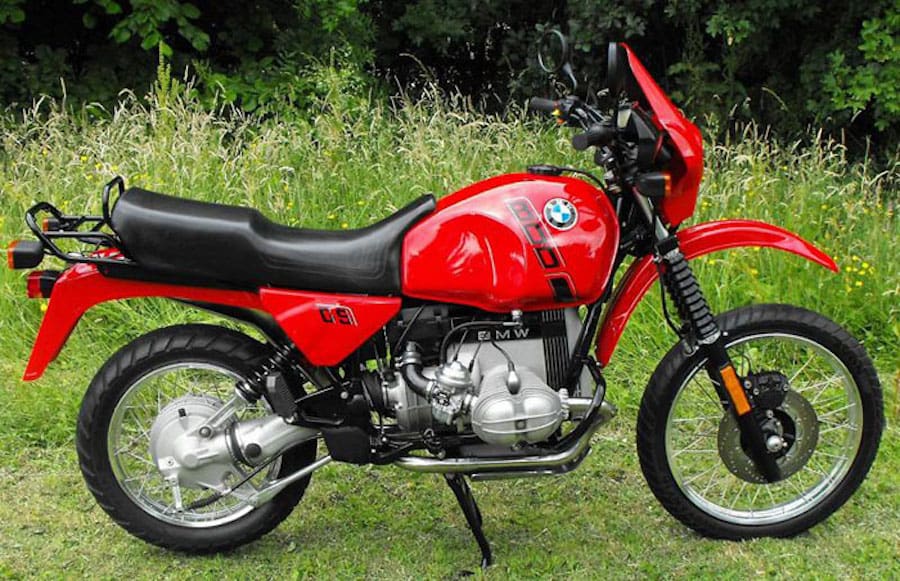BMW’s release of its R80G/S, a 798cc, flat-twin adventure tourer, was a milestone moment in modern motorcycle history. Its arrival on showroom floors in 1981 meant buyers looking for a capable daily commuter that doubled as dirt-road tourer were no longer limited to 500cc single-cylinder ‘thumpers’.
Paris-Dakar Rally wins demonstrated the new Beemer’s off-road credentials. On the bitumen it was a serious touring bike, capable of covering long distances way more smoothly and swiftly than any of the 500cc singles. Then in 1988, taking to the next level everything learned from its R80G/S (and later R80GS) model experience, BMW released the R100GS, boasting a 980cc engine along with a bunch of other upgrades.
This machine was sophisticated for its day and was rewarded with a model run right through to the end of BMW’s airhead era in the mid-90s. Today a well-maintained R100GS can double as a capable adventure tourer and a desirable and collectable classic.
Its air-cooled, two-valve, twin-carb engine and five-speed gearbox are housed in a tubular-steel twin-cradle frame. The long-travel suspension employs a 40mm Marzocchi fork up front and a Paralever single-sided swingarm (incorporating driveshaft) with adjustable monoshock at the rear. Single discs at both ends handle the braking.
The spoked wheels (17-inch rear and a dirt-friendly 21-inch front) have trick alloy rims with rim-edge spokes to allow the use of tubeless tyres.
As long as you’re okay with the tallish 850mm seat height, you’re immediately at home in a
comfortable saddle and well in charge thanks to wide handlebars. Ergonomics are tops for both rider and passenger.
The torque-rock response when you blip the throttle from the along-the-frame crankshaft is a pleasant reminder that you’re on a boxer Beemer.
All the controls operate smoothly and you soon adjust to the slightly ponderous gearshift action.
The GS feels lighter than its 207kg (dry) weight because the flat-twin engine arrangement makes for a low centre of gravity, despite the bike’s relatively high stance.
While its modest 45kW maximum power means it’s no bitumen-burner, the engine’s torquey nature produces decent acceleration and gives the bike the ability to plug on manfully up hills and in and out of bends without the need for constant gear changing.
Handling is very good, as is the feel of the bike on the road; the Paralever swingarm provides shaft-drive convenience without much shaft-drive ‘presence’. Earlier BMWs equipped with the Monolever swingarm exhibited the classic shaft-drive tendency to rise or squat at the rear with changing throttle inputs. The wide handlebars largely overcome the slow-steering bias of a 21-inch front wheel on a swift run through tight mountain twisties. While the long-travel suspension can make the bike feel a little unsteady close to its bitumen cornering limits, it more than compensates through its ability to soak up mid-corner potholes and irregularities.
Braking is up to the task. However, owners wanting to boost its stopping power could take the advice of my BMW boxer guru mate, who reliably informs me the four-piston Brembo caliper from the left side of the firm’s heavier K1100LT is a straight bolt-on swap for the R100’s standard twin-piston caliper.
The Paris-Dakar (or PD) version – which features a larger fuel tank, hard panniers as standard fitment and upgraded protection bars and a luggage rack – usually attracts a higher price than the standard version, depending, of course, on its condition.
While it’s not compulsory to ride around Australia on your R100GS (as so many owners seem to have done), owning one can provide opportunities for a great deal of varied riding pleasure and a happy ownership experience. The simplicity and robustness of its construction, the ready availability of spare parts and accessories, and the ease of maintenance keep the cost of airhead-GS ownership affordable.

Building Bricks
Here are the bikes that mark the evolution of the BMW GS
BMW GS80/GS900
1979-80 – The factory’s first large-capacity enduro racers provide the inspiration for boxer-powered dual-sports bikes for
the road.

BMW R80G/S
1981 – BMW adds the R80G/S adventure tourer to its roadbike line-up, featuring Monolever driveshaft-swingarm with monoshock suspension.

BMW R80GS
1987 – Paralever version of the R80GS introduced, providing improved rear suspension performance and durability, setting the stage for the R100GS.

WHAT TO LOOK FOR
An airhead GS is a pretty tough bike. However, look for subframe cracks and tired rear shocks.
With high-kilometre examples, listen for the rumble of worn gearbox bearings with the engine running in neutral. The fix – bearings, seals and expert shimming – will cost around $1000.
As always, adjust your offer to cover worn consumables such as tyres, steering-head bearings and brake discs and pads.
Award extra points to examples with lower kays, full service records and no signs of damage
or neglect.
SERVICE HISTORY
The BMW R100GS is an ideal bike for capable DIY owners to look after in terms of normal servicing.
The air-cooled flat-twin boxer set-up means that access to sparkplugs, carbs and even valve-gear is a piece of cake. It’s all out there, more or less on display. The high ground clearance helps with access as well.
Chris Roberts at BM Motorcycles recommends servicing at 7500km intervals. He says it’s good insurance to change gearbox and final-drive oil whenever you change engine oil and filter.
Price Guide
New Price
$10,560 (1988)
$13,700(1994)
Second-Hand
$3600-$8600

WORDS ROB BLACKBOURN
PHOTOGRAPHY AMCN ARCHIVes











